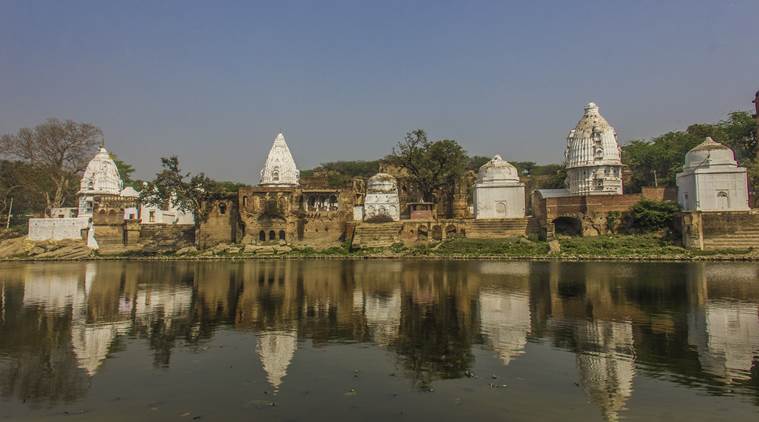
It wasn’t a bright idea to head to Bateshwar on Holi, I thought. But thanks to the vicissitudes of an ambitious schedule, we packed ourselves into a car at 5 am and hurtled along. All we wanted was a snack and caffeine to banish the drowsiness, but there was not a dhaba in sight. Just before we reached the village, I found a small shack. There was some syrupy tea and savouries left over from the night before — enough to kick-start the day.
A fortnight prior to the visit, I was clueless about the place. Online searches threw up blurry shots of white blotches beside a river, unhelpful descriptors (“timeless”, “calm”) and unsubstantiated comparisons (Varanasi, Pushkar). But the thrill of exploring a place not to be found in travel brochures drew me.
About 70 km south-east of Agra, the Yamuna loops like a crazed gymnast. Along one of the crescents it etches, lie Bateshwar and its 40-odd temples, all gleaming white. By the time the Yamuna reaches the village, it is no more the frothy sewer of Delhi or the garbage-doused trickle of Agra. It becomes a respectable river, albeit murky and smelly. Turtles bask on rocks, their heads outstretched towards the warmth of the sun. Fish frolic in the waters, sending bubbles to the surface. But what makes it particularly spectacular are the pearl-like temples along its bank, their reflections swaying gently with the current.
The village comprises just one road, along which the temples and a couple of houses are laid out. On Holi, everything was shut, including the lone public toilet — not that it mattered much considering there was nothing to eat or drink either. As I walked along the ghats, I was surprised by how calm the place was. Holy towns in India have many charms, but quietude is not one of them. In Bateshwar, however, you are free to do as you please without encountering a hard sell for heaven. Pandits don’t coerce you into paying to absolve your sins, nor do alms-seekers try to augment your good deeds. And that’s how it remains for most of the year, except on certain festive occasions.
The main shrine, Bateshwarnath, is festooned with hundreds of bells. It is the only one that draws a sizeable footprint; the rest are pleasantly desolate. They say once there were 101 temples along the river, but a ravenous flood in 1978 destroyed most. Interestingly, their architectural styles are diverse. Some feature a Nagara-style shikhara, while others sport domes topped with finials that are reminiscent of Lodhi tombs.
While I couldn’t find much about the place online, the villagers are generous with information. “Bateshwar is more than 7,000 years old,” says Sanjay Chaturvedi, a resident of neighbouring Holipura. I was afraid I would have to sit through a seven-millennia recap, but he soon moved to more verifiable history. “The village was part of the Bhadawar kingdom. In 1646, Raja Badan Singh built the Bateshwarnath temple. The kings of Gwalior and Bharatpur also constructed some of the shrines.”
Far more interesting than the historiographical attempts are the legends religious sites incubate. “On a hunting expedition, the Bhadawar king shot a tiger,” recounts Vishwaveer Bhadoria, a tea-stall owner. “The animal died in Mainpuri and the Chauhan ruler staked claim to it. The emperors were ready to battle when the latter’s minister counselled that they should avoid conflict. The kings feasted on the tiger together and vowed to get their children married to broker lasting peace.
However, the Chauhan ruler already had a daughter and the Bhadawar queen bore a girl. To honour the pact, she raised her child as a boy. On the day of the wedding, the Bhadawar scion was distraught as everybody would eventually find out the truth. So she decided to kill herself and jumped into the Yamuna. There she saw Lord Shiva, who beckoned, “Come to me, son.” “Don’t call me son. I’m a girl,” she replied. “No, you’re a boy,” declared Shiva, and soon enough, she emerged from the river a man and solemnised the wedding. To thank the lord, the king built a temple and a dam to change the course of the river so that it stays by the shrine.” (While the Yamuna largely flows to the south-east, at Bateshwar it flows in the north-west direction.)
There’s only so much one can absorb on an empty stomach. “Are you going to open your stall today?” I asked. “No,” he replied. Hunger pangs gnawing, we thought of skipping the Jain temple on the village outskirts, but then, stopped by briefly. It was a drab concrete structure — quite unlike the marvels by the river — but what surprised me were the crowds. I burst with delight on finding the reason — there was a bhandara (community feast) in the temple! Volunteers ushered us and served puris with mashed pumpkin curry and fried potatoes. Maybe it was because I found food when I least expected it or maybe it was the paroxysms of sweet and savoury that each bite of the pumpkin unleashed, but I shall always remember Bateshwar as a divine place. And a place where women can transform into men, albeit to preserve heteronormativity.
Syed is a Delhi-based writer. This article appeared in the print edition with the headline ‘Miracles in a temple’